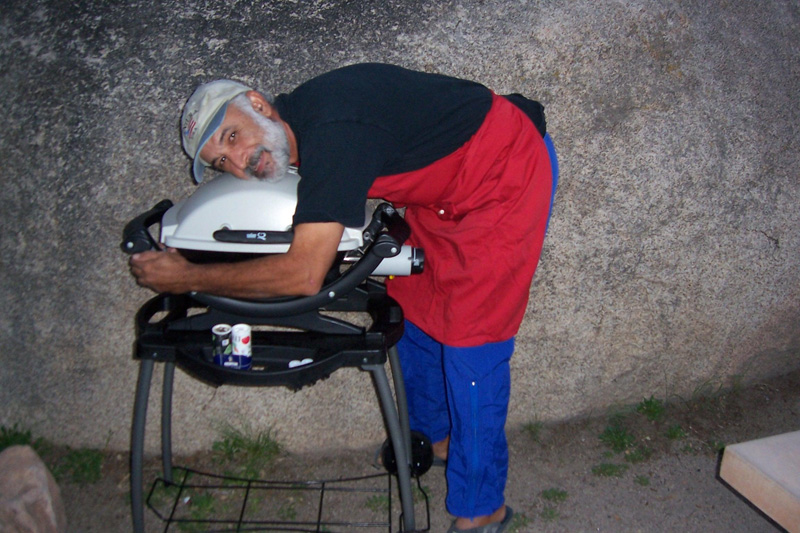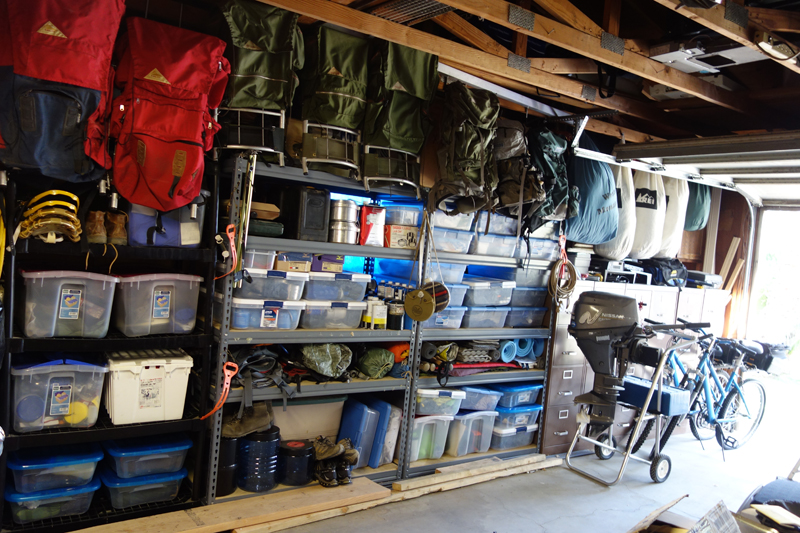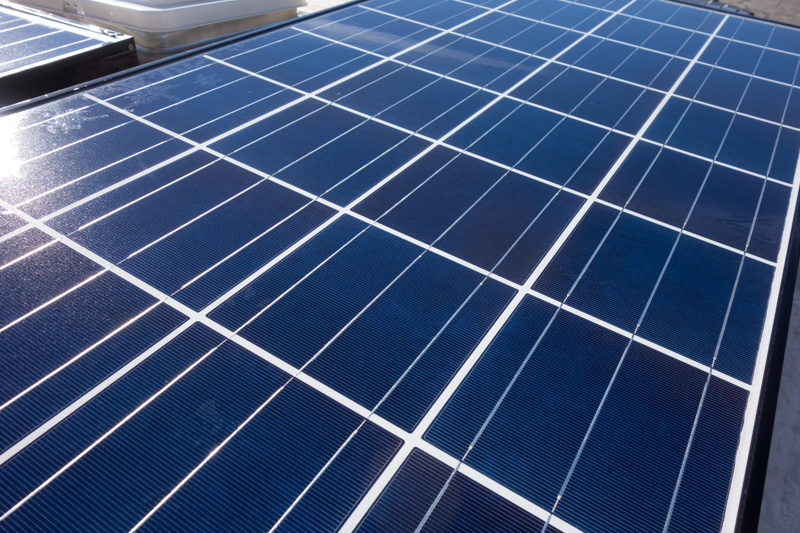It is common for backpacking bloggers to publish their favorite gear for the year. I have done this every year since 2012, and there has only been one change to my favorite gear in four years as documented in my favorite backpacking gear for 2015. This is different than most backpackers, who seem to have new favorite gear each year, which leads me to believe that their focus is gear-centric and not walking-centric. This begs the question, why do so many backpackers constantly buy new gear? Is it consumerism or do they not focus on skills instead of magic equipment to keep them safe in the backcountry? I’ll let you, the reader, sort out that conundrum.
I have never posted a list of my favorite camping gear. I have been camping for over 50 years and for the past 25 years it has included a camper. The previous 25 years I camped with a tent. In 2003 I refined my camping equipment and little has changed since then, other than we have bought two larger campers over the past 10 years.
So instead of presenting my favorite camping gear for 2015, I will share my favorite 3 of all time.
CAMPING VS. BACKPACKING
Before sharing my favorite camping gear, a quick baseline discussion is appropriate. As I explained in Which is Better: Camping or Backpacking. I enjoy both and neither is superior. To me, camping is about setting up a base camp and each day exploring my surroundings and returning to my house on wheels at the end of the day. Backpacking is going from point A to Point B during a multi-day period, requiring one to carry their house, gear, food and water on their back. There are similarities and differences between each.
Backpackers might find my favorite backpacking gear more appropriate to their needs than campers will find my favorite camping gear useful to them. Two of my favorite pieces of camping gear really require a camper, although they could be used for tent camping.
Because Joyce will never go backpacking, but loves to camp, we camp together often. When not camping, she is okay with me going on my solo backpacking trips. This gives me more outdoor time each year than most people even dream about.
For the first 25 years of camping, I “car camped” – meaning all the camping gear had to be loaded into the vehicle before each trip and then unloaded when I got home. All of this was a lot of work. Plus a tent was my shelter and all campsite tasks were rather primitive and time consuming.
In 1992, I bought my first camper, a small Starcraft Meteorite tent trailer. It was one of the smallest and lightest camping trailers on the market. It was very spartan, really a tent on wheels. But most of the camping gear could be stored in it, it was quicker and easier to set up than a tent, and afforded more weather protection and comfort than a tent. At the time my kids were 5 and 7 years old and the camper made or trips much more enjoyable.
In 2001 I took Joyce on her first camping trip. She was hooked on camping, but the camper was a little too basic for her. Soon we embarked on many upgrades to our Starcraft Meteorite. By the end of 2003, we had our camper “dialed in” and perfect for us.
Later we would buy a 2006 Fleetwood Niagara tent trailer and then our current 2014 Milan 26RLS. Based on what we learned from camping in the Starcraft, there were 3 “must haves” and we incorporated all 3 BEFORE embarking on the maiden voyages in the Niagara and then the Milan. These are my favorite camping gear items of all time.
#1 – SOLAR SYSTEM
Solar can open up more camping opportunities.
Aside from the free camping sites on BLM and USFS land, most of our other camping is in National Forest or National Park Service campgrounds, which do not have hook-ups. Since I am over 62, I have a Senior America the Beautiful Pass. There is a one time fee of $10 and most Federal campgrounds give us a 50% discount on campsites. Our cost per night at these campgrounds run $5 to $10 per night.
In 2014 we camped for 30 nights at Lake Mead for a total cost of $150, 14 nights at June Lake in the Eastern Sierra for $140, and 60 nights in Joshua Tree and the Mojave Preserve for a total of $360. So for $650 we spent 104 camping nights in Federal campgrounds, at an average of $6.25 per night. I bet the average cost of State, County, and Private campgrounds in California is over $30 per night. 104 nights at $30 would be $3,120 – so I figure we saved at least $2,470 in 2014 alone, which more than paid for our solar and other electrical upgrades. So for us the ROI on solar for each of our 3 campers was less than a year each. We can make real toast in our toaster for breakfast or even watch movies on our 32″ TV if we want. We could even use our microwave oven if we want, but we always cook outdoors. However, even without solar I would camp in the same places as we now do. I camped for the first 10 years I owned our ’92 Starcraft without a battery at all.
Here is a tidbit… in 2005 we traveled to Colorado for the PUX gathering at Rocky Mountain National Park. PUX is the online forum community at www.popupexplorer.com. While setting up our camper, I was talking to a lot of the PUX folks and forgot to switch my fridge from 12 volt to LPG. For some reason, that camper’s fridge would not stay lit on propane when traveling. So in the morning my battery bank was down to 10% usable amp hours. For most people this would be a disaster. Two days later we were up to 100%. Solar saved us.
Of course most people aren’t going to camp over 100 nights a year or live as close to so many camping opportunities as we do. Keep in mind that one of the main reasons I moved to Palm Springs in 1977 was its proximity to so many recreational areas. Once we are both retired (soon), we will up our camping to 200 hundred nights a year. Unfortunately my wife won’t let me sell the house and camp full time, which is okay — I can use a portion of the remaining 165 days to go backpacking, which is free.
No way would I go camping for extended periods without solar. A generator could do the same job as our solar system, but I disdain generators, even the so-called quiet Honda and Yamaha generators are too noisy for me, plus they require maintenance and gasoline. I wash my solar panels two or three times a year and that just takes a few minutes along with a little soap, water, and Windex.
The solar system on our Milan is pretty much state of the art RV solar today.
You may also be interested in our Tent Trailer Solar Systems.
My three part series on how to size an RV solar system starts with How to Size an RV Solar System: Part 1
This website may be compensated for linking to other sites for sales of products. As an Amazon Associate I earn a small fee from qualifying purchases at no additional cost to the purchaser.
#2 – BABY Q GRILL

Even though our camper has a stove and oven inside, we do most of our cooking outside. We can grill, bake, and cook food on it. Sometimes, on long trips, we supplement it with our Camp Chef stove.
Some posts of interest:
#3 – OLYMPIAN WAVE 8 HEATER

This gem is much more efficient than a RV furnace. You can read my long term review here.


![[Reliable] Advanced encapsulation material with multi-layered sheet laminations enhance cell performance and provide a long service life. EL-tested solar panels; no hot-spot heating guaranteed. Bypass diodes minimize power drop caused by shade.TPT ba...](https://m.media-amazon.com/images/I/419Ww9WyUoL._SL160_.jpg)


